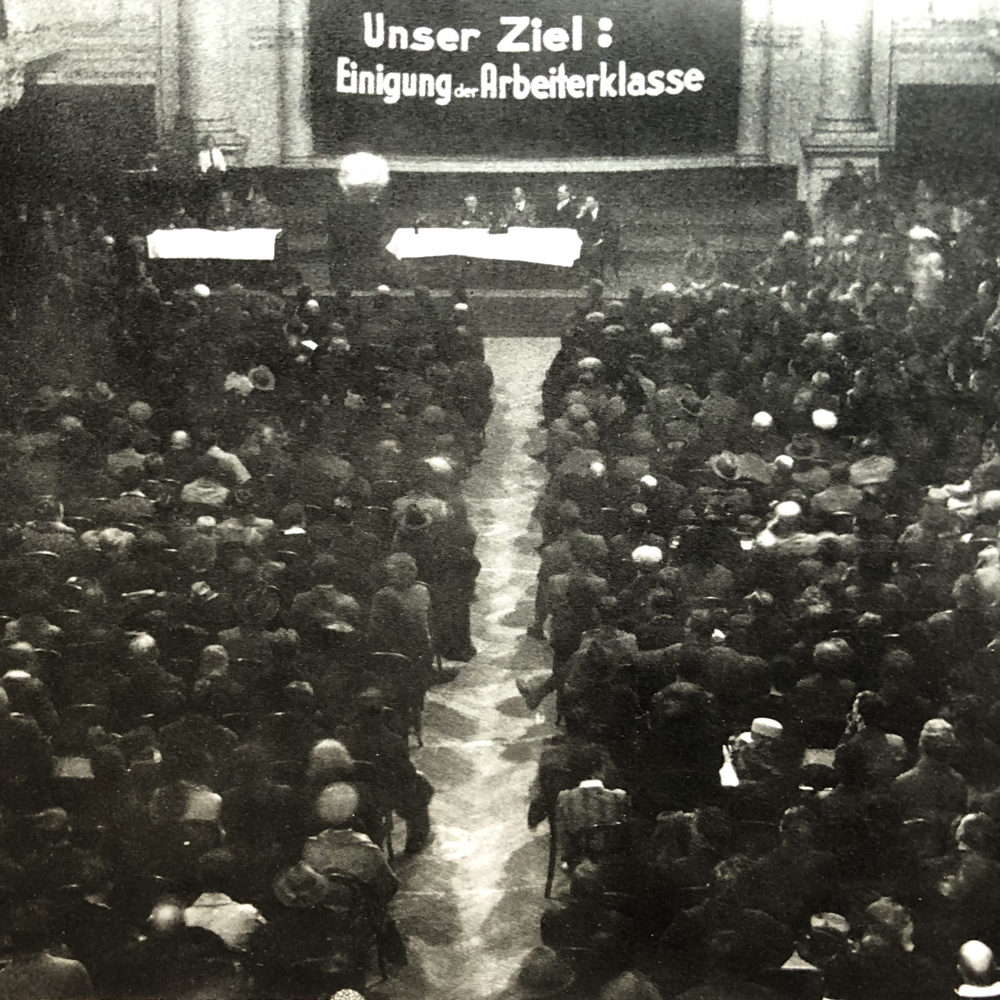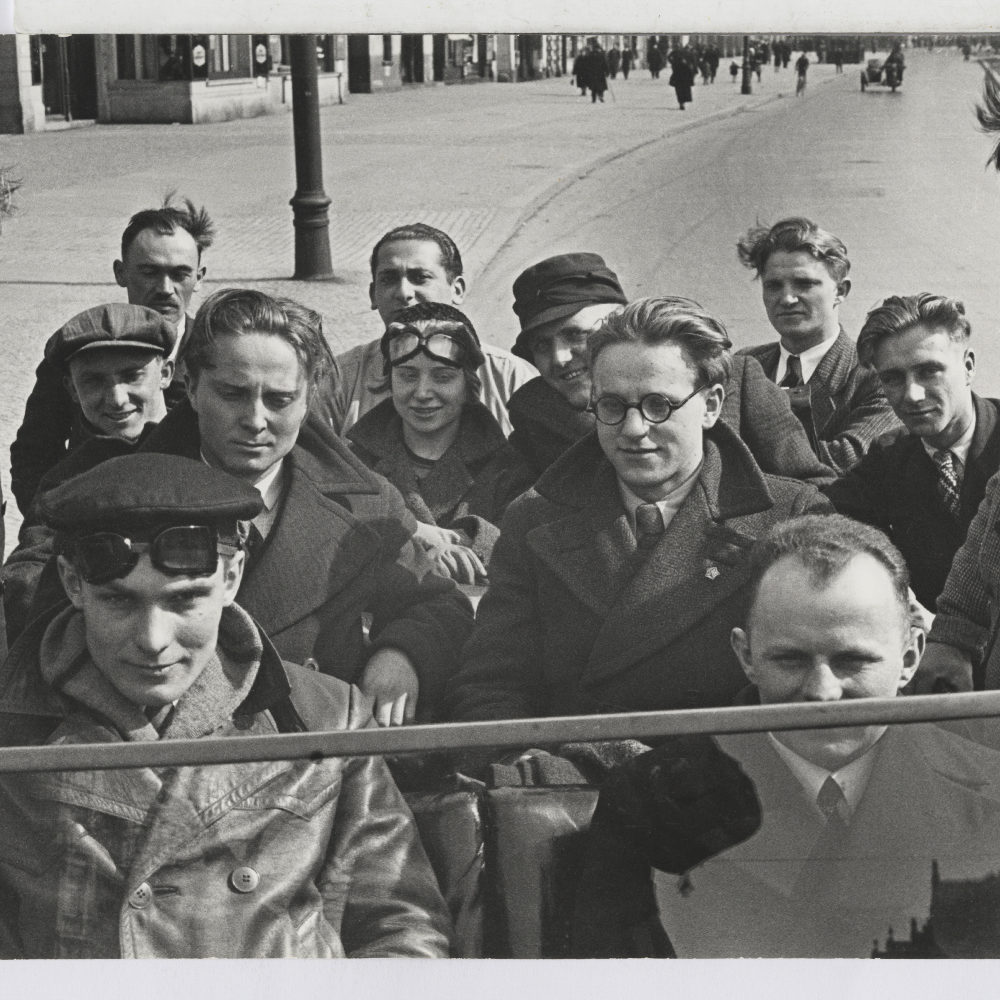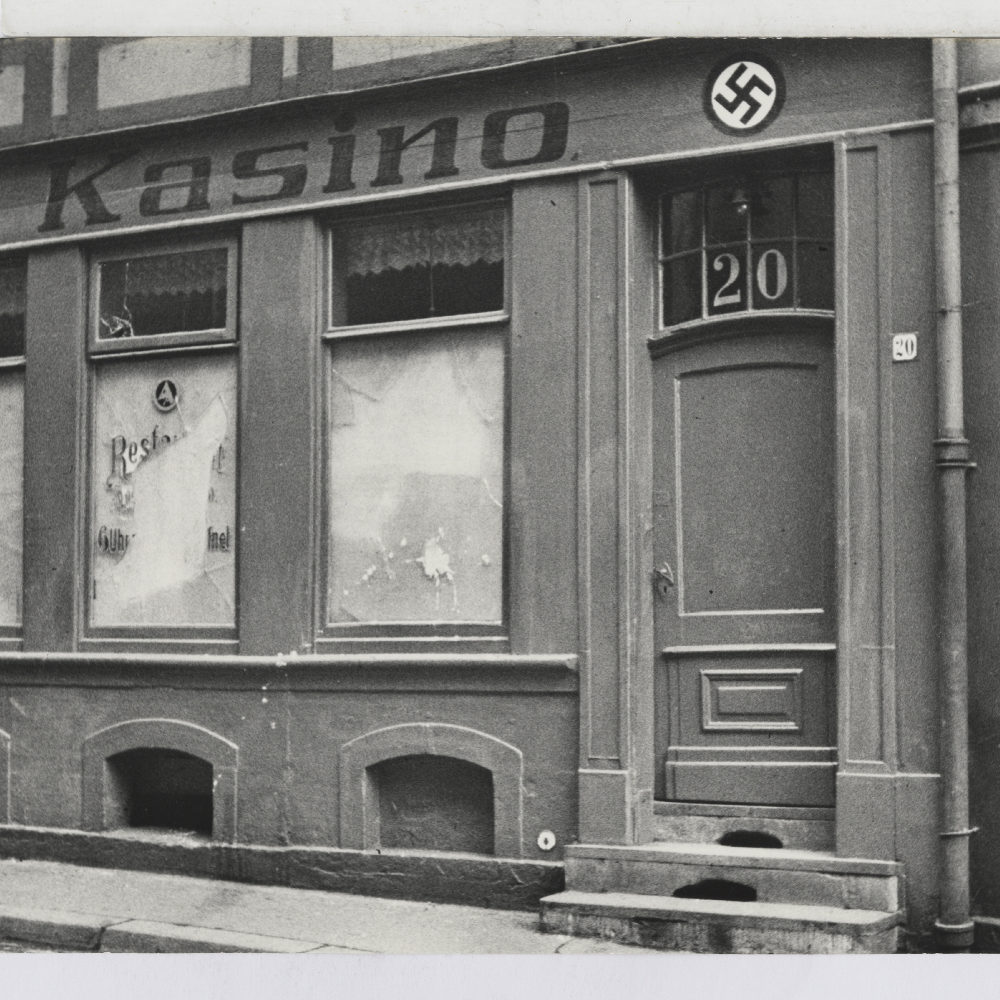In the waning years of the Weimar Republic, the local group of the Socialist Workers’ Party of Germany [Sozialistische Arbeiterpartei Deutschlands, abbreviated to SAP] meets in the “Bunte Tavern” in the heart of Hanover’s old town. The aim is to form a united front against the increasingly powerful political right. After the National Socialists come to power, the group goes underground before being crushed in 1935.
![Hanover: The agitprop group "Rote Kolonne” [Red Column] in the backyard of the Bunte Tavern in Knochenhauerstrasse, June/July 1932. In the middle of the back row is workers' photographer Walter Ballhause. In the middle row on the left is Fritz Treu and Ilse Rohrer who was later to become his wife, at the front on the right is Otto Brenner's brother Kurt Brenner. Walter Ballhause Archive, Plauen Hanover: The agitprop group "Rote Kolonne” [Red Column] in the backyard of the Bunte Tavern in Knochenhauerstrasse, June/July 1932. In the middle of the back row is workers' photographer Walter Ballhause. In the middle row on the left is Fritz Treu and Ilse Rohrer who was later to become his wife, at the front on the right is Otto Brenner's brother Kurt Brenner. Walter Ballhause Archive, Plauen](https://zukunft-heisst-erinnern.de/wp-content/uploads/2020/02/R_SAP_Bunte_1.jpg)
Caught between the SPD and the KPD.
The Socialist Workers’ Party or SAP is founded in the autumn of 1931 as a left-wing breakaway group from the Social Democratic Party of Germany, the SPD. The trigger is the expulsion from the party of nine Reichstag members who, amid the onset of mass unemployment, fail to vote in line with their parliamentary group in favour of the construction of a warship. They are joined by other members of the SPD and the Communist Party of Germany [Kommunistische Partei Deutschlands, abbreviated to KPD] who, disillusioned with the policies of their parties, want to push for a united front of the left in the face of rising fascism in Germany. In spite of their very realistic assessment of the political situation, the SAP never gets beyond the magnitude of a splinter party; in the two Reichstag elections of 1932, it achieves 0.2 and 0.1 per cent of the votes cast. Prominent among its members of the day are Willi Brandt from Lübeck, who later becomes German Chancellor, and Otto Brenner from Hanover, who went on to become the long-serving chairman of IG Metall [Industrial Union of Metalworkers].
The SAP in Hanover
In contrast to mainstream parties like the SPD, the commitment and internal party-political life in small parties is usually very intense. This is also evident in the Hanover branch of the SAP. And their members are very young – on average around 25 years old. Very many of them have embarked on their political involvement at an early age, starting in the Socialist Workers Youth of the SPD, and then in protest they switch to the SAP.
Their numbers are small. The SAP in Hanover has only about 100 members, plus the same number in the youth organisation. The Hanover SPD, on the other hand, has approximately 17,500 members in around 1933 and the KPD about 2,000. But the level of activism within the SAP is high. Everybody knows everybody. Weekly training courses take place in a private apartment, meetings of members are held at “Bunte” in what was then Knochenhauerstrasse 63 (today roughly house number 5). There is a function room in the rear building where the “Red Column” [“Rote Kolonne” political theatre group] practices and literary evenings are held. The hall in the “Burghaus” on the nearby banks of the Leine is often hired for large events.
“Red Column”
The year 1932 is an eventful one – for both Germany and Hanover. In the Reich presidential election in April, Hitler wins just under 40 per cent of the vote in Hanover. In two Reichstag elections in one year, the SPD loses to the National Socialists in its traditional stronghold of Hanover. Violent clashes between left and right regularly erupt on the streets. Amidst this heated atmosphere, the fringe party SAP campaigns for the left to form a united front by organising about 60 events in and around Hanover.
Always part of the programme is the party’s own agitprop group “Red Column” performing political cabaret and workers’ songs. On 22 June 1932, the SAP’s “Socialist Workers’ Newspaper” [Sozialistische Arbeiterzeitung], published in Breslau, reports in the language style of the time on a meeting held in Wennigsen am Deister at which the united front, comprising the SPD, KPD and SAP, had already been achieved with some 800 attendees: “Red Column” revue troupe, Hanover, opened the event with the chorus “Ready for battle” [Kampfbereit], their troupe song and latest political cabaret. “We stand united”, yet “that was the past, the future is us”. Its effect was massive, its lyrics expressed what everyone was feeling”.
A series of three pictures by SAP member and workers’ photographer Walter Ballhause depicts the members of “Rote Kolonne” in the backyard of the “Bunte Tavern” with raised clenched fists. On one of them he himself can be seen in the back row. He has evidently handed his camera to someone else, who – clearly without experience – clips the feet of the people in the front row. Pictured are, amongst others, Fritz Treu and his future wife Ilse Rohrer (second and third from the left) and Otto Brenner’s younger brother Kurt Brenner (fourth from the right).
The fight goes underground
As late as 27 January 1933, the most important theorist of the SAP, Fritz Sternberg, speaks in the hall of the Burghaus on the subject of “The Decline of German Capitalism and the Role of the Working Class”. Four days later, Adolf Hitler is appointed Reich Chancellor. The terror against the left after the Reichstag fire of 27 February also hits the SAP in the shape of arrests and the banning of its press; its last party conference in Dresden takes place in mid-March in circumstances that now render it illegal.
On 1 May 1933, whereas Hanover’s trade unions already voluntarily gather under swastika flags on Waterlooplatz, a photo shows the rest of the local SAP membership – about 20 women and men – at a secret May Day meeting in the open air in Misburger Holz [nowadays known as Misburger Wald]. Otto Brenner keeps in touch with the clandestine party leadership in Berlin as a courier – at times by bicycle – and arranges for information from them to be printed and distributed to members and sympathisers. In keeping with the times, the technology is very simple: he writes onto wax stencils using a typewriter and then, helped by his brother Kurt and others, creates copies using a duplicating drum. Otto Brenner and other party members in Berlin and Hanover are discovered by the Gestapo as early as August 1933. The leaders that took over are caught in September 1934. The group’s trial before the Hamm Higher Regional Court ends in 1935 with in some cases heavy prison sentences, while Otto Brenner gets off comparatively lightly with two years in prison. This marks the end of the SAP’s illegal work in Hanover, and personal contact with each other remains cautious until the end of the war.
Additional online information
Wikipedia entry Socialist Workers’ Party of Germany SAP
Wikipedia entry Walter Ballhause
Vocational training school of Metal Technology • Electrical engineering in the Hanover region. Otto-Brenner-Schule: Who was Otto Brenner? [in German]
Further reading: Click here
Texts and images: Michael Pechel


![Hanover: The agitprop group "Rote Kolonne” [Red Column] in the backyard of the Bunte Tavern in Knochenhauerstrasse, June/July 1932. In the middle of the back row is workers' photographer Walter Ballhause. In the middle row on the left is Fritz Treu and Ilse Rohrer who was later to become his wife, at the front on the right is Otto Brenner's brother Kurt Brenner. Walter Ballhause Archive, Plauen](https://zukunft-heisst-erinnern.de/wp-content/uploads/2020/02/R_SAP_Bunte_1-1000x1000.jpg)

